This is a follow up my earlier post about my BMW R100CJ and whether or not this model was a predecessor to the R100 Mono Classic that appeared in the USA around 1991/92. For reference, here is a link to my earlier post.
https://forums.bmwmoa.org/showthread.php?96459-The-elusive-R100CJ-(R100-Classic-for-Japan)
If you prefer to watch rather than read, here’s a link to a video of my R100 Trad: https://youtu.be/3tYMlIEDiP4
Just to recap on the R100 Mono Classic; it’s generally accepted that 180* units of this bike were shipped to the USA around 1991/92, and this website seems to be the best central resource in terms of the summarizing the limited amount of known data points for this specific model. http://bmbikes.co.uk/specpages/r100mono.htm
*Note: Ian Falloon’s excellent “BMW Boxer Twins Bible” book states that 157 of the R100 Mono Classic were imported into the USA between 1991/92. I suspect 180 were actually built because I have been in contact with the current owners of bike #174 and bike #109, but exactly how many of the 180 units physically made it to USA, only BMW and the importers would truly know.
I would note that some of the photos of the R100 Mono Classic on the BMBikes website are not entirely accurate in the sense that they depict a Japanese version of the bike: http://bmbikes.co.uk/photopages/photosr100mono.htm
However, that’s not necessarily a bad thing because it got me thinking about my own R100 that was manufactured in September of 1990, before being shipped to Japan, and then owned by one person until it was imported into Australia in 2014. I originally thought my bike was one of the 180 R100 Mono Classics from 1991/92 that had somehow found its way to Japan, but when I started cross referencing the Chassis numbers and on-line photos, I started to think that the Japanese “version” of the 1991/92 USA R100 Mono Classic might actually have been a distinct R100 “Classic” in its own right, and in many ways a pre-cursor to the USA R100 Mono Classic.
My first solid clue was this Japanese auction site (in Russian!) which, if you use Google Translate, clearly shows around 25 unique R100CJ (Classic for Japan) bikes passing through the Japanese auctions over the past few years. These bikes seem to have been manufactured between 1990 and late 1991. http://motobay.su/brands/13/models/...&f_score_m=all&f_price_m=all&f_status_all=all
I tried unsuccessfully to find any other references to the R100CJ on the internet (even though my bike has that code stamped onto the frame as part of the Chassis number), but I then struck “gold” with this Japanese website which talks about the R100 Trad (Trad = Traditional)
https://www.virginbmw.com/oldgetnavi/og32/
And for those of you who are not able to use Google Translate, here is the English translated version of the website:
History of R100 Trad
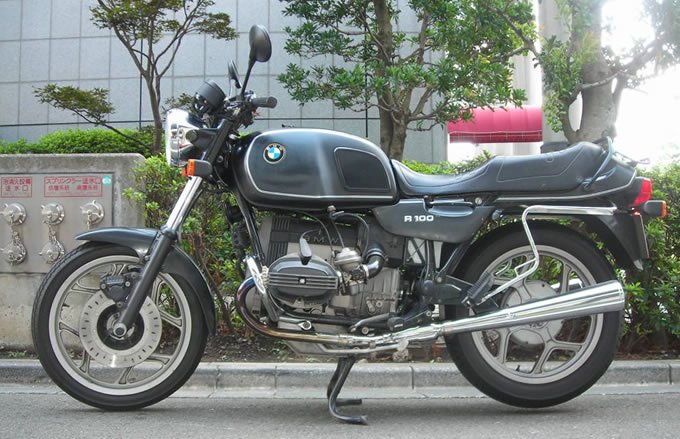
[begin translation] The model introduced here is the R100 that appeared in July 1990 and was imported and sold for only two years (named R100 Trad in Japan). It is a model in which 100 units were imported in the first year (1990) and approximately 100 units were imported in the following year (1991).
Before the release, I have been asked, "I'll get a model for a certain country to Japan, but do you think it will sell?" The initial selling price was 1.22 million yen, but it soon changed to 1.25 million yen. In the same model, K1 was 20.30 million yen, K75S was 1.34 million yen, R100RS was 1.5 million yen, and R100GS was 1.35 million yen. At the beginning of the sale, there were no large-scale advertisements, so the number of sales was not good. However, as we saw vehicles at the store, the number of orders gradually increased, and many people were looking for them even after they were out of stock.
After the new bike was sold out, used bike came into play, but most of the people who bought the bikes liked the style, so few used bike came out. The R80 of the same style was a new bike for 1.09 million yen, but many people waited patiently until a used bike in the 900,000 yen range came out. There were only approx. 200 bikes imported into Japan, so this used bike doesn't come out so much that it seems to be useless now.
Features of R100 Trad
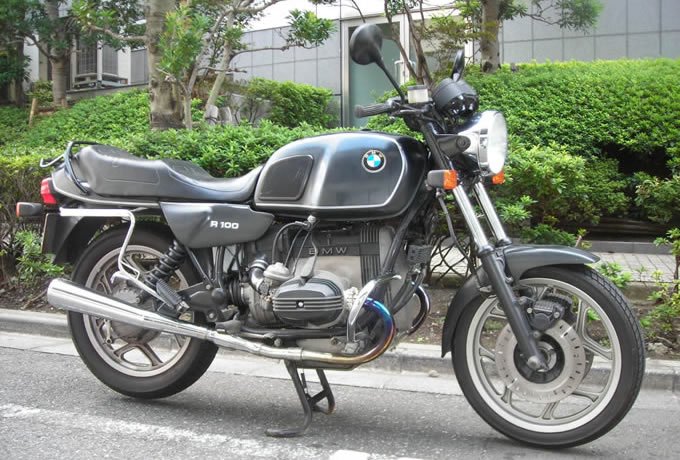
The model called R100 Trad is a model that removes all the fairing from the R100RS and RT sold at that time, and thins the seat. The bike body color is just one classic black and no other colors exist. At first glance, it is difficult to distinguish from R80 before 1990, and it is necessary to always check the frame number and the model of bike verification, etc. without judging only by the letters and style of the side cover.
There are two types, R80 / 100 and R100. The engine model is 102VC only. The body structure is almost the same as R100RS and RT. However, there were some different parts. The seat comes standard with a special low seat that is said to have been made by the “Kawana Sheet”. About 3 centimetres lower than the standard sheet, the width is narrower, and the footing property of the harder ones is good. The tool box under the seat is omitted because the thickness is secured by projecting to the lower side. A small cockpit cowl attached around the headlight is an accessory often used in new bikes. Although the genuine product was expensive with a clock and voltmeter inside, the installation rate was high. There are a lot of similar items from outside the company and they are mixed. The handlebar is the same as R80. The accessories attached to the vehicle are often the same as R and K, and there were various things such as grip heaters, large and small side bags, and small top cases.

Japan original part
A specially-shaped low seat with good footing, said to be made of “Kawana Sheet”. A tool box is not attached.
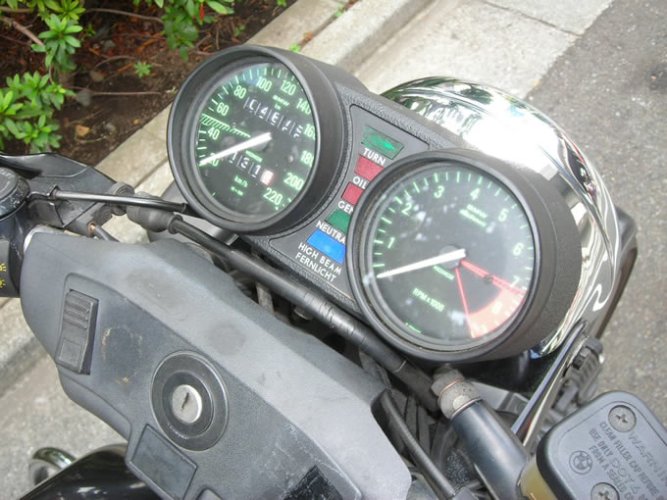
Instrument panel
The R series after 1980 has almost the same design. Note that the gear ratio varies depending on the model.
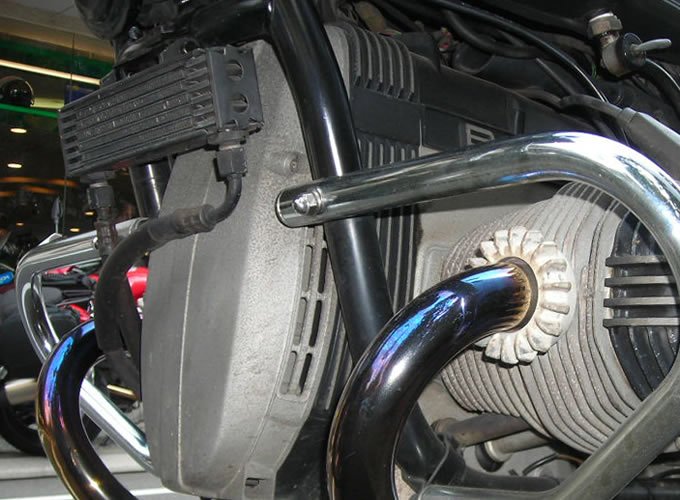
Oil cooler with presence
The R100 series is equipped with an oil cooler for all bikes, but only the Trad without the cowl is exposed.[end of translation]
I thought it would be interesting to do a cosmetic comparison between the USA R100 Mono Classic and my own Japanese R100 Trad. Not very scientific, but short of putting both bikes side-by-side, it’s the best I could do.
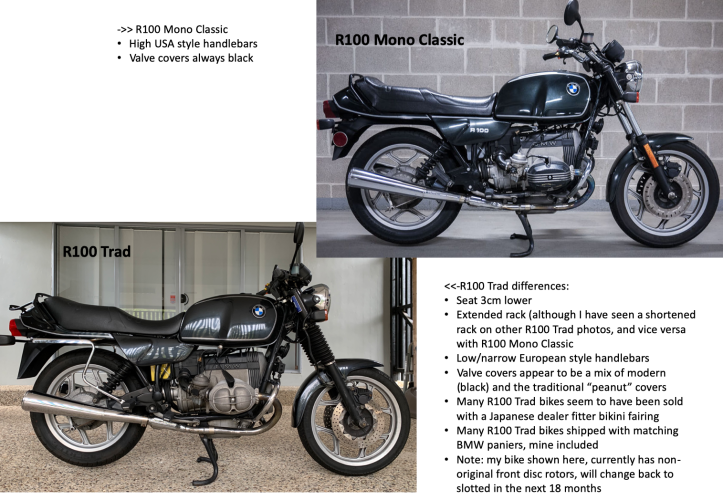
The remaining question would then be, what prompted BMW to place a 980cc engine into an R80, ship 200 of these bikes to Japan from 1990-91 and call them a R100 Trad?
I have been in contact with two BMW dealers in Japan (Rinto Sereno and Dusty Motorcycles) and both dealers confirmed the following:
• In 1989, BMW Security & Authority Vehicles received an order from the Egyptian Police for an unspecified number of R80 bikes, but with a upgraded 980cc engine (the same engine as used on the R100RS which was still in production)
• BMW began processing the Egyptian order, but in early 1990 the Egyptian Police deferred their order (one could speculate that this could have been because of the Gulf War which broke out in August 1990 when Iraqi forces invaded Kuwait)
• It is not clear whether the Egyptian Police took delivery of any of the bikes before deferring the order
• What we do now know is that BMW secured a new customer for the deferred Egyptian order, and that was BMW Motorrad Japan
• BMW Motorrad Japan elected to market the bikes in Japan as the R100 Trad (Trad for Traditional)
• During the 1st half of 1990 BMW started to manufacture the R100 Trad using Chassis numbers from the existing R80 series, and including a suffix of R80CJ
• After the July/August 1990 summer BMW factory shutdown, production of the R100 Trad continued, Chassis numbers from the R80 series continued to be used, but now a suffix of R100CJ was use (note: all R100 Trad bikes, regardless of their R80CJ/R100CJ Chassis numbers have a 980cc engine and 32mm Carbs).
Another piece of evidence that supports the “Egyptian deferred order” theory is the fact than when I enter my R100 Trad’s Vin/Chassis number into the BMW Parts Catalogue it displays a message “Special Vehicles – Authorities Egypt”. Also when I enter the Vin/Chassis numbers from the bikes shown here: http://motobay.su/brands/13/models/...&f_score_m=all&f_price_m=all&f_status_all=all the “Special Vehicles – Authorities Egypt” message is also displayed.
One could surmise that a year later, the success of those 200 bikes in Japan, led to another 180 (or 157!) very similar bikes being shipped to the USA as the R100 Mono Classic.
So…if you’ve made it this far!..that brings this little bit of investigation to a close in the sense that I have identified that from 1990-91 BMW produced around 200 units of the R100 Trad for the Japanese market. These bikes were based on the R80 chassis but they had a 980cc engine (as requested by the Egyptian Police), and they can be distinguished from the USA R100 Mono Classic by way of a 3cm lower seat and European low/narrow handlebars. But of course both sets of bikes sport that gorgeous Chrome headlamp cowling!
In closing, I would love to hear from any owners of the R100 Trad from Japan, Australia, New Zealand or anywhere else in the World for that matter. I would also love to hear of any supporting facts (or counter suggestions) in terms of the Egyptian Police deferred order theory.
Some other useful links:
• Interesting Japanese Blogs for the R100 Trad:
o https://blog.goo.ne.jp/w3skyblue/c/a09bbdba832a0f0c12673a38b04ced41
o http://ofdustandnations.blogspot.com/2016/04/bmw-r100-trad.html
o http://blog.fukuda-motors.co.jp/article/213056272.html
• Youtube: BMW R100 Trad (aka R100CJ) and the R100 Mono Classic
• YouTube: The elusive 1991 BMW R100 Classic
• YouTube:Shindo Car New Car R100 BMW Shipment from Sendai R100R R Kana
• YouTube:1991 BMW R100 Classic, pristine condition
• YouTube – Algerian Authorities R80 from 1991: https://www.youtube.com/watch?v=uY1KSYOTc84&list=WL&index=47&t=0s
https://forums.bmwmoa.org/showthread.php?96459-The-elusive-R100CJ-(R100-Classic-for-Japan)
If you prefer to watch rather than read, here’s a link to a video of my R100 Trad: https://youtu.be/3tYMlIEDiP4
Just to recap on the R100 Mono Classic; it’s generally accepted that 180* units of this bike were shipped to the USA around 1991/92, and this website seems to be the best central resource in terms of the summarizing the limited amount of known data points for this specific model. http://bmbikes.co.uk/specpages/r100mono.htm
*Note: Ian Falloon’s excellent “BMW Boxer Twins Bible” book states that 157 of the R100 Mono Classic were imported into the USA between 1991/92. I suspect 180 were actually built because I have been in contact with the current owners of bike #174 and bike #109, but exactly how many of the 180 units physically made it to USA, only BMW and the importers would truly know.
I would note that some of the photos of the R100 Mono Classic on the BMBikes website are not entirely accurate in the sense that they depict a Japanese version of the bike: http://bmbikes.co.uk/photopages/photosr100mono.htm
However, that’s not necessarily a bad thing because it got me thinking about my own R100 that was manufactured in September of 1990, before being shipped to Japan, and then owned by one person until it was imported into Australia in 2014. I originally thought my bike was one of the 180 R100 Mono Classics from 1991/92 that had somehow found its way to Japan, but when I started cross referencing the Chassis numbers and on-line photos, I started to think that the Japanese “version” of the 1991/92 USA R100 Mono Classic might actually have been a distinct R100 “Classic” in its own right, and in many ways a pre-cursor to the USA R100 Mono Classic.
My first solid clue was this Japanese auction site (in Russian!) which, if you use Google Translate, clearly shows around 25 unique R100CJ (Classic for Japan) bikes passing through the Japanese auctions over the past few years. These bikes seem to have been manufactured between 1990 and late 1991. http://motobay.su/brands/13/models/...&f_score_m=all&f_price_m=all&f_status_all=all
I tried unsuccessfully to find any other references to the R100CJ on the internet (even though my bike has that code stamped onto the frame as part of the Chassis number), but I then struck “gold” with this Japanese website which talks about the R100 Trad (Trad = Traditional)
https://www.virginbmw.com/oldgetnavi/og32/
And for those of you who are not able to use Google Translate, here is the English translated version of the website:
History of R100 Trad

[begin translation] The model introduced here is the R100 that appeared in July 1990 and was imported and sold for only two years (named R100 Trad in Japan). It is a model in which 100 units were imported in the first year (1990) and approximately 100 units were imported in the following year (1991).
Before the release, I have been asked, "I'll get a model for a certain country to Japan, but do you think it will sell?" The initial selling price was 1.22 million yen, but it soon changed to 1.25 million yen. In the same model, K1 was 20.30 million yen, K75S was 1.34 million yen, R100RS was 1.5 million yen, and R100GS was 1.35 million yen. At the beginning of the sale, there were no large-scale advertisements, so the number of sales was not good. However, as we saw vehicles at the store, the number of orders gradually increased, and many people were looking for them even after they were out of stock.
After the new bike was sold out, used bike came into play, but most of the people who bought the bikes liked the style, so few used bike came out. The R80 of the same style was a new bike for 1.09 million yen, but many people waited patiently until a used bike in the 900,000 yen range came out. There were only approx. 200 bikes imported into Japan, so this used bike doesn't come out so much that it seems to be useless now.
Features of R100 Trad

The model called R100 Trad is a model that removes all the fairing from the R100RS and RT sold at that time, and thins the seat. The bike body color is just one classic black and no other colors exist. At first glance, it is difficult to distinguish from R80 before 1990, and it is necessary to always check the frame number and the model of bike verification, etc. without judging only by the letters and style of the side cover.
There are two types, R80 / 100 and R100. The engine model is 102VC only. The body structure is almost the same as R100RS and RT. However, there were some different parts. The seat comes standard with a special low seat that is said to have been made by the “Kawana Sheet”. About 3 centimetres lower than the standard sheet, the width is narrower, and the footing property of the harder ones is good. The tool box under the seat is omitted because the thickness is secured by projecting to the lower side. A small cockpit cowl attached around the headlight is an accessory often used in new bikes. Although the genuine product was expensive with a clock and voltmeter inside, the installation rate was high. There are a lot of similar items from outside the company and they are mixed. The handlebar is the same as R80. The accessories attached to the vehicle are often the same as R and K, and there were various things such as grip heaters, large and small side bags, and small top cases.

Japan original part
A specially-shaped low seat with good footing, said to be made of “Kawana Sheet”. A tool box is not attached.

Instrument panel
The R series after 1980 has almost the same design. Note that the gear ratio varies depending on the model.

Oil cooler with presence
The R100 series is equipped with an oil cooler for all bikes, but only the Trad without the cowl is exposed.[end of translation]
I thought it would be interesting to do a cosmetic comparison between the USA R100 Mono Classic and my own Japanese R100 Trad. Not very scientific, but short of putting both bikes side-by-side, it’s the best I could do.

The remaining question would then be, what prompted BMW to place a 980cc engine into an R80, ship 200 of these bikes to Japan from 1990-91 and call them a R100 Trad?
I have been in contact with two BMW dealers in Japan (Rinto Sereno and Dusty Motorcycles) and both dealers confirmed the following:
• In 1989, BMW Security & Authority Vehicles received an order from the Egyptian Police for an unspecified number of R80 bikes, but with a upgraded 980cc engine (the same engine as used on the R100RS which was still in production)
• BMW began processing the Egyptian order, but in early 1990 the Egyptian Police deferred their order (one could speculate that this could have been because of the Gulf War which broke out in August 1990 when Iraqi forces invaded Kuwait)
• It is not clear whether the Egyptian Police took delivery of any of the bikes before deferring the order
• What we do now know is that BMW secured a new customer for the deferred Egyptian order, and that was BMW Motorrad Japan
• BMW Motorrad Japan elected to market the bikes in Japan as the R100 Trad (Trad for Traditional)
• During the 1st half of 1990 BMW started to manufacture the R100 Trad using Chassis numbers from the existing R80 series, and including a suffix of R80CJ
• After the July/August 1990 summer BMW factory shutdown, production of the R100 Trad continued, Chassis numbers from the R80 series continued to be used, but now a suffix of R100CJ was use (note: all R100 Trad bikes, regardless of their R80CJ/R100CJ Chassis numbers have a 980cc engine and 32mm Carbs).
Another piece of evidence that supports the “Egyptian deferred order” theory is the fact than when I enter my R100 Trad’s Vin/Chassis number into the BMW Parts Catalogue it displays a message “Special Vehicles – Authorities Egypt”. Also when I enter the Vin/Chassis numbers from the bikes shown here: http://motobay.su/brands/13/models/...&f_score_m=all&f_price_m=all&f_status_all=all the “Special Vehicles – Authorities Egypt” message is also displayed.
One could surmise that a year later, the success of those 200 bikes in Japan, led to another 180 (or 157!) very similar bikes being shipped to the USA as the R100 Mono Classic.
So…if you’ve made it this far!..that brings this little bit of investigation to a close in the sense that I have identified that from 1990-91 BMW produced around 200 units of the R100 Trad for the Japanese market. These bikes were based on the R80 chassis but they had a 980cc engine (as requested by the Egyptian Police), and they can be distinguished from the USA R100 Mono Classic by way of a 3cm lower seat and European low/narrow handlebars. But of course both sets of bikes sport that gorgeous Chrome headlamp cowling!
In closing, I would love to hear from any owners of the R100 Trad from Japan, Australia, New Zealand or anywhere else in the World for that matter. I would also love to hear of any supporting facts (or counter suggestions) in terms of the Egyptian Police deferred order theory.
Some other useful links:
• Interesting Japanese Blogs for the R100 Trad:
o https://blog.goo.ne.jp/w3skyblue/c/a09bbdba832a0f0c12673a38b04ced41
o http://ofdustandnations.blogspot.com/2016/04/bmw-r100-trad.html
o http://blog.fukuda-motors.co.jp/article/213056272.html
• Youtube: BMW R100 Trad (aka R100CJ) and the R100 Mono Classic
• YouTube: The elusive 1991 BMW R100 Classic
• YouTube:Shindo Car New Car R100 BMW Shipment from Sendai R100R R Kana
• YouTube:1991 BMW R100 Classic, pristine condition
• YouTube – Algerian Authorities R80 from 1991: https://www.youtube.com/watch?v=uY1KSYOTc84&list=WL&index=47&t=0s
Last edited:
